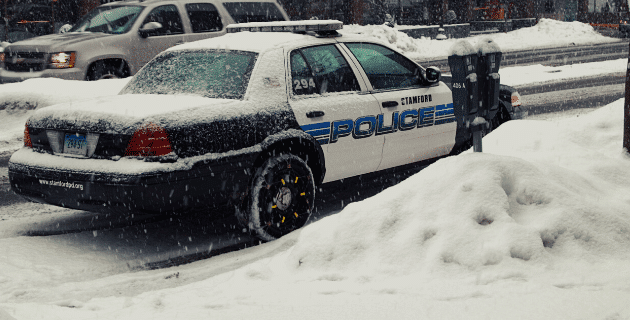
by California Casualty | Peace Officers |
It’s cold out there, and if you’re a cop on the beat this winter, you’ll definitely feel it. While winter weather may be uncomfortable, exposure to the cold can be deadly, and frostbite can be permanently disabling.
Take steps to make sure you’re safe and comfortable this winter with a cold weather survival kit for your patrol vehicle. Most of these items you can find inexpensively locally or online, or you may already have them on hand. So the next time the temperature dips, and you’re driving around this winter, you’ll be ready.
1. Thin wool or fleece gloves – Use these as your backup pair in case you need them, or as additional insulation under your heavy gloves. Inexpensive military surplus glove liners work well because they don’t take up much space. The wool keeps you warm even if it gets wet.
2. Hand warmers – These warmers are oxygen-activated. You can get ones that last for 12 hours, which will cover your shift. You can place them in gloves, boots, hats, vests, or pockets for an extra boost of warmth when you’re patrolling, directing traffic, or standing around in the cold.
3. Snowmobile balaclava – This windproof headwear is thin and stretchable, so it easily fits under hats and works well with uniforms. It’s made to wear under a snowmobile helmet, and it effectively shields your head, face, and neck.
4. Plastic trash bag – Trash bags have great insulating properties, which makes them ideal for covering up a tear in a uniform. They also are effective barriers from wet, icy or snowy surfaces if you might have to sit down on one.
5. Glow stick necklaces – Snap these necklaces and they give off a glow that can be seen at night. If you’re ever about to fall unconscious, wrap one around your arm or attach one to your neck. You can also use them in a pinch if the battery in your flashlight dies. These sticks will glow for 8 to 12 hours.
6. Packets of instant coffee, hot cocoa, tea bags – Pack your hot beverage of choice for a quick pick me up. Just add hot water, available at most convenience stores. A hot beverage can help you maintain body temperature on frigid nights and keep you hydrated.
7. A large zipper food bag or vacuum pack bag – Store your kit in a waterproof bag that’s easy to carry. A large zipper food bag is light and foldable. You also could pack everything in a vacuum-sealed food bag. Whatever you use, make sure your cold weather survival kit is with you wherever you go this winter.
More cold weather tips
Working in the cold is an added stress for law enforcement. Make sure you are fully prepared.
- Police uniforms are not necessarily made for warmth, and you may not even be issued a winter version. Make sure you’re protected with good outerwear and base layers, especially if you’re working in conditions under 30 degrees Fahrenheit.
- Insulated underwear comes in different weights. Choose the weight you need based on the weather. Remember that a good base layer is odor resistant, quick to dry, and soft on the skin.
- Insulated duty boots protect your feet and keep them warm during the toughest conditions.
- Warm socks made for the weather will help. Wool retains heat even if wet and lets your feet” breathe.”
- Insulated hats prevent heat loss through your head.
- Warm gloves protect your hands but can affect your fingers’ ability to move. Make sure you practice with your gloves on as you deploy your baton, TASER, OC, handcuffs, magazines and pistol.
- Equipment can freeze and malfunction due to the cold. Keep a small black sack with hand warmers and put your radio in it to keep the battery from freezing. Wrap your flashlight with hockey friction tape so the cold metal won’t stick to your skin if you touch it with bare hands. Put a coat of silicone inside your holster to more easily draw your weapon, and do a half-draw if you’re out in the cold for a period of time.
- You depend on your cars to keep you warm. Snap-on grille covers help keep the cold air outside from coming in.
Stay safe out there.
This article is furnished by California Casualty, providing auto and home insurance to educators, law enforcement officers, firefighters, and nurses. Get a quote at 1.866.704.8614 or www.calcas.com.
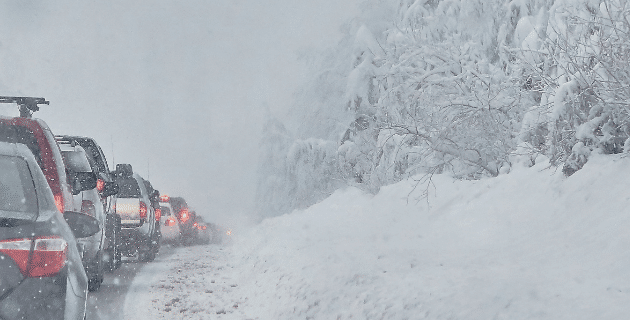
by California Casualty | Auto Insurance Info, Homeowners Insurance Info, Safety |
When the temperatures dip low, wind speeds hit high, and precipitation is in the forecast, you could be in the path of a winter storm. These powerful acts of nature have the potential to cut off power and trap you and your family in your home for days, and that’s not all… Winter storms have also been associated with hypothermia, frostbite, carbon monoxide poisoning, and even heart attacks.
Being well prepared is your best defense. Follow this guide so you can weather winter storms safely.
Know what to expect when
The National Weather Service issues severe weather alerts for winter storms. While the exact amounts of snow vary based on where you live, here are some general definitions.
-
- Winter storm watch – Conditions are right for hazardous winter weather within 48 hours. It doesn’t mean it will occur, but a winter storm is possible.
- Winter storm advisory – Usually issued within 36 hours of an expected storm, an advisory lets you know to anticipate snow, sleet and/or freezing rain.
- Winter storm warning – Expect snow, sleet, ice, freezing rain and/or hazardous winter conditions within the next 12-24 hours.
Get ready
Your primary concerns during a severe winter storm are the loss of heat, power, and communications, having enough food and supplies, and protecting your home from possible storm damage. Stock up on supplies, take protective measures for your home and create a disaster plan to share with everyone in the family. That may include planning for evacuation if needed.
Stock up and charge up- Building your emergency kit.
-
- Stock up on food that requires no cooking or refrigeration. Make sure you have a manual can opener if you’re planning to open cans.
- Include baby food and diapers if needed.
- Buy cases of bottled water to use in case the pipes freeze. You can use this for brushing teeth, flushing toilets, and bathing. Make sure you have at least 3 gallons of water per person. You can also fill the bathtub with water as an extra source.
- Make sure you have enough prescription medications, and any toiletries needed.
- If you have pets, stock up on food for them.
- Gather your flashlights and extra batteries. Collect candles and matches.
- Pull out the battery-powered radio for weather updates. You can also use it to play music to pass the time.
- Make sure you have lots of blankets and warm clothes for each member of the household.
- Charge all of your devices ahead of the storm. Charge any portable battery backups. Determine how you will charge your phone during a power outage.
Protect your home
-
- Make sure your home’s furnace is in good working order.
- Check for drafts and use these winter window hacks to keep your home warm and toasty.
- Know how to turn off your utilities, such as gas lines or water, in an emergency.
- Consider buying emergency heating equipment such as a wood or coal-burning stove or electric or kerosene heater. Review all safety precautions, and be careful of fire hazards when storing fuel.
- Consider installing a portable generator. Review generator safety and never run a generator in an enclosed space.
- Make sure your smoke detector and carbon monoxide detectors are working. If you’ll be using your fireplace or wood stove for heat, they should be near that area. Have a fire extinguisher nearby just in case, or try this way to put out fires without an extinguisher.
- Test your snow blower and have it serviced if necessary.
- Take a walk around your house and identify any trees that could fall. If there’s time, trim them back.
Be prepared to leave if needed
-
- Service your vehicle and make sure you’re prepared for winter. Have a mechanic check your antifreeze, windshield-washer fluid, defroster, wipers, battery, brakes, and tires.
- Keep your car’s gas tank full for emergency use.
- Stock your car with these must-carry items.
- Research local shelters and warming stations in your area in case you need to evacuate your home.
- Prepack a bag for each member of the family, including pets.
Once the Storm Arrives
During the storm…
-
- Limit your time outside. Hypothermia and frostbite are real dangers.
- Do not attempt to travel during treacherous conditions. You could find yourself in an accident or stranded on the road.
- Stay tuned to emergency weather alerts.
- Check on neighbors if they’re older or have young children who are more at risk in extreme cold.
After the storm…
-
- Avoid driving until conditions have improved. Follow winter driving safety guidelines.
- Keep a supply of kitty litter and/or ice melt to clear sidewalks.
- Be careful to not overexert yourself. It’s common for heart attacks to be brought on by overexertion from shoveling or clearing snow.
- Assess any damage to your home or property and alert your insurance company. You have home insurance for a reason. Put it to work if you need it.
This article is furnished by California Casualty, providing auto and home insurance to educators, law enforcement officers, firefighters, and nurses. Get a quote at 1.866.704.8614 or www.calcas.com.
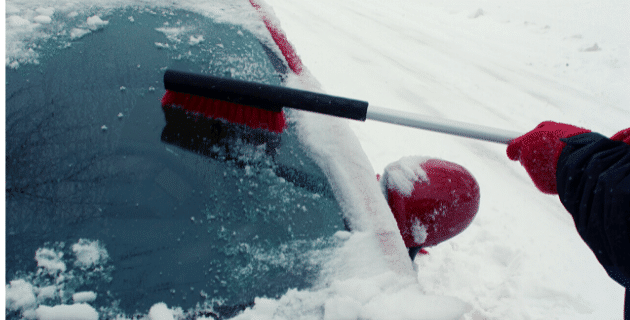
by California Casualty | Auto Insurance Info |
Winter driving presents its share of challenges, from icy road conditions to car batteries that strain due to the cold. If you live in a region where the temperatures dip down low, you could be sitting in a freezing car for hours if it breaks down.
Thankfully, some forethought and preparation can help. Make sure you’re fully prepared for whatever winter throws at you and stock up on these must-carry items for your emergency winter car kit this season.
#1: Ice scrapers, snow brushes, and a foldable shovel
It’s important to clear your whole car before you drive. Snow and ice can slide from your vehicle’s roof and obstruct your view while driving. It also could fly off and hit another car. Choose scrapers and brushes with long handles that allow you to reach the top of your vehicle. Stock several and the kids can help, too! Get a portable snow shovel too, one that folds so it takes up less space. Then use it to dig your car out as needed.
Tip: You can also use the shovel to add fresh snow or dirt around your tires to help them grip.
#2: A bag of sand or kitty litter
Your car may get stuck in the snow or be unable to move past an icy spot. Pour some sand or kitty litter over your tires and/or on the ground for extra grit to help with traction.
Tip: You can put your car’s floor mats down in front of your tires to get your car out of slippery situations. Watch the video from Firestone.
#3: Hazard triangles and LED flares
When you break down on the side of the road, you want to be seen—by other vehicles and by emergency personnel who can assist you. That’s the purpose of the hazard triangles and LED emergency flares. These are especially important when there is reduced visibility such as at night or during snowstorms.
Place the reflective hazard triangles behind your vehicle starting at 10 feet and going as far as 100 feet. Road flares have traditionally been used to mark sites for emergency responders. Rather than the traditional flares that light like a match and ignite, choose the modern version—a LED safety flare. They are designed to be waterproof, shatterproof, and crushproof and some are even magnetic and can stick right to your car.
Tip: To reduce the drain on your battery, use your car’s emergency flashers only if you hear vehicles approaching.
#4: A flashlight (and some extra batteries)
A flashlight can help you find things in the dark. It also can be used to signal passing cars. Choose an LED flashlight that offers plenty of light. If you can, pack several flashlights so that everyone in the family has one. Store batteries backward in the flashlight to prevent the light from accidentally switching on and burning out. Keep a spare set of batteries on hand just in case.
Tip: Pack some glow stick necklaces for the kids. They’re also great fun and an easy way to find everyone in the dark.
#5: Jumper cables and a battery charger
Low temperatures put an additional strain on your car’s battery. In fact, the freezing cold can turn a weak battery into a dead one overnight. If your car breaks down due to a dead battery, jumper cables can help. These cables allow you to charge your car’s battery from another car’s. You also may want to invest in a portable battery jump starter. These devices jump your battery without another car. They also can power your other devices such as cell phones or tablets.
Tip: Find out much battery life you have left with a free battery test at Firestone.
#6: A cell phone charger and portable power bank
Your cell phone is your connection to the world—and to help. Keep it as charged as possible by having a charger in your car. However, if your car doesn’t start, the car charger won’t do much good. Be sure to pack a portable battery or power bank.
Tip: If you’re stuck and your cell phone is losing power, change your outgoing message to your current location, time and date, and any other important details. That way, if your cell phone stops working, callers will get that message.
#7: Blankets and cold weather clothes
Keep a few blankets or sleeping bags in your trunk. If you want to save on room, choose pocket-size heat-reflective blankets. Then, stock some warm clothes for every member of the family: old sweatshirts, thick pants, warm socks, boots, mittens, and warm hats. Add some hand or feet warmers, which could provide much-needed warmth in an emergency.
Tip: Don’t run your car’s engine unless you are sure the exhaust pipe is free of snow. Snow can plug your vehicle’s exhaust system and cause deadly carbon monoxide gas to enter your vehicle.
#8: Snacks and water
If you’re spending any significant time in your car, you’ll want food and water. Keep water bottles and non-perishable snacks in your car through the winter. Consider these ideas: prepackaged trail mix or nuts/seeds, dried fruit, granola bars, chocolate, dry cereal, crackers, cookies, peanut butter (or other nut butters), rice cakes, pretzels. Choose kid-friendly snacks in case the kids are with you; you’ll enjoy them even if they’re not there.
Tip: For a more substantial snack, pack canned food that can be eaten cold and a can opener. Don’t forget the plastic utensils.
#9: Entertainment
Keep the kids busy with some games and activities. This will help keep them from feeling stressed and it will help pass the time. Pack a travel game bag. Include decks of cards, puzzles, coloring books and crayons or paper for older kids, and travel games. Sing songs, tell jokes, and keep the time as light-hearted as possible.
Tip: Make it a game. Take a poll on how long it will take to get home or what the tow truck driver will look like.
#10: First Aid Kit
A first aid kit is especially needed in winter because emergency response times may be longer due to icy or snowy conditions. You can buy one or make your own. Include bandages, gauze, adhesive tape, antibiotic ointment, scissors, saline solution for eye washing or cleaning wounds, aloe vera to treat minor burns, an antihistamine for allergic reactions, and anything else your family may need.
Tip: Add baby wipes, which will help if you or the kids have to go to the bathroom outdoors in nature. A garbage bag can also be a makeshift toilet if need be.
You can save some steps and buy emergency roadside safety kits that combine many of the items on this list.
Finally, should you have a winter-related accident or incident, know that your collision and comprehensive insurance will help protect you.
Safe travels.
This article is furnished by California Casualty, providing auto and home insurance to educators, law enforcement officers, firefighters, and nurses. Get a quote at 1.866.704.8614 or www.calcas.com.
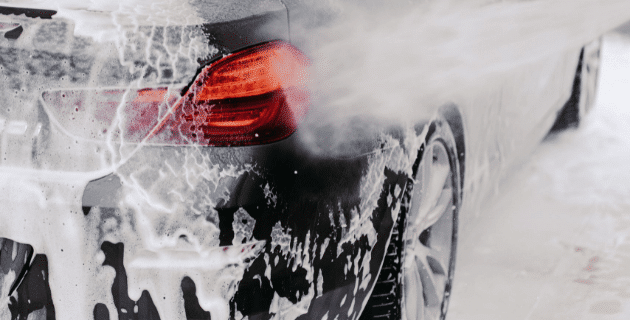
by California Casualty | Auto Insurance Info |
Winter is hard on our cars. Between ice and snow, road salt and dirt, our vehicles often get covered in grime.
But the dirty car you see is just the beginning. Salt, sand, dirt, ice, and rotting leaves can lead to rust which eats away at the exposed metal and causes mechanical issues as well as hurts your car’s resale value.
Keeping your car washed and clean during the cooler months is the best way to protect it from damage. And it will also help keep it from aging. Here’s some more information on why you should keep your vehicle washed this winter.
Winterize your car—before winter.
Before the temperatures dip down, take some time to prepare your car for the winter weather.
-
- Give your car a thorough wash and rinse, paying special attention to areas where salt, sand, and ice can collect such as on the undercarriage and in little crevices.
- Apply a coating of wax, which can help protect against road salt and other debris.
- If you wish, you also can get glass coatings, plastic trim coatings, and paint coatings at your local automotive supply store.
- Switch out cloth floormats for all-weather rubber ones. They will be easier to clean during the winter months.
Make sure you do it on a warm day, 50 degrees or above, or indoors. Cold temperatures make it hard for wax or polish to dry and cure properly.
Wash your car every few weeks.
Your car doesn’t have to be visibly dirty to give it a wash. You should schedule one every couple of weeks throughout the winter.
If washing a car at a car wash…
-
- Choose touchless car washes rather than the ones with the big twirling brushes. They will be gentler to your car’s paint.
- Pay the extra to have your undercarriage sprayed. This is where salt and dirt tend to adhere.
- Make sure your car is dry when you leave. Road salt and dirt stick to wet cars.
If washing a car at home…
-
- Drive your car around the block a few times and crank up the heat to warm it up first.
- Wear waterproof gloves, clothes, and boots.
- Remove snow, ice, and other debris from the car.
- Use warm water to help wash away the initial coat of road grime.
- Use a car wash detergent. (Avoid dish soap which can be hard on your car’s paint.)
- Pay attention to the wheels and undercarriage. These areas are most affected by winter driving.
- If you like, instead of the traditional wash, you could try a “rinse-less” or waterless wash. You may purchase these washes at your local auto supply store. Make sure to have lots of microfiber towels if you choose this option; you will need them.
- When you are finished with the wash and rinse, run the wipers for 10 seconds. This clears away excess water that can freeze later on.
- Open your car doors and dry the rubber weather seals to help prevent them from freezing shut. Do the same around your windows and your fuel door.
Importantly, though, if the temperatures dip below 30 degrees, skip the wash. You will end up with frozen locks and door handles.
Look out for rust.
Rust forms when iron-based metals such as steel are exposed to oxygen. The rust is actually the breakdown of the metal. It’s common for rust to first appear during the winter months. Luckily, you can stop rust in its tracks. It’s important to take care of rust, because it’s considered normal wear and tear, and isn’t usually covered on your car insurance policy.
-
- Check your car for rust each time you wash it. Lower door corners are popular places for rust to appear, as are wheel wells in front and behind tires.
- Identify the kind of rust. See this article in Popular Mechanics on how to fix each kind.
- Surface rust includes scratches and cracks in the paint.
- Scale rust shows up as bubbles in the paint.
- Penetrating rust appears as flakes of metal and holes.
This article is furnished by California Casualty, providing auto and home insurance to educators, law enforcement officers, firefighters, and nurses. Get a quote at 1.866.704.8614 or www.calcas.com.
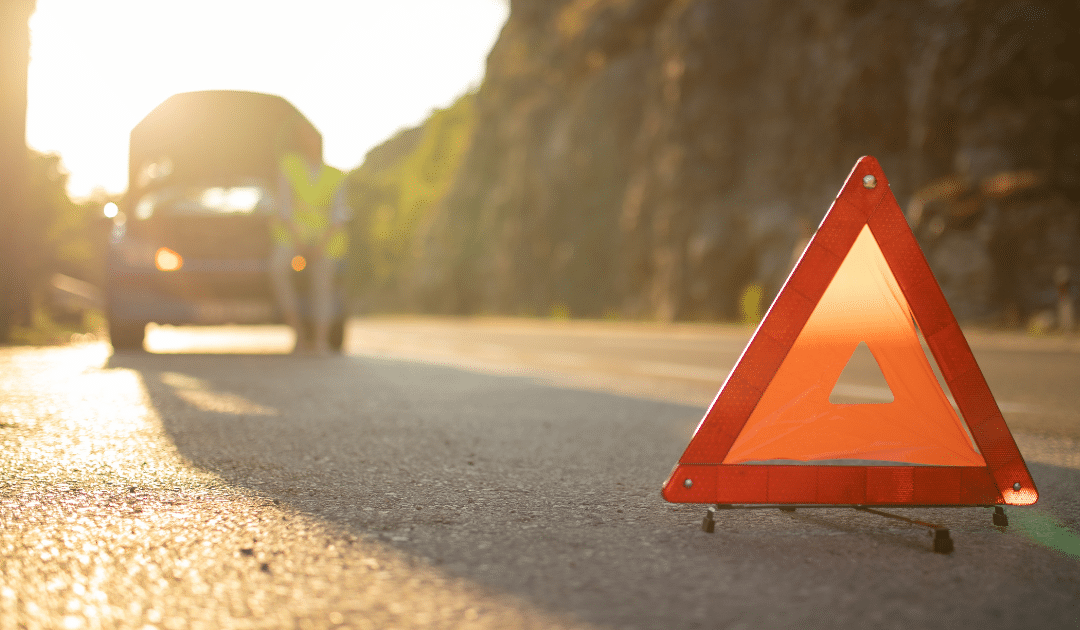
by California Casualty | Auto Insurance Info |
It’s hot… but you’re not the only thing feeling the heat. Rising temperatures are not only dangerous for us; they can also wreak havoc on our vehicles.
As the summer heat bears down in the midst of vacation and road trip season, here’s what you can do to help better protect your car on and off of the road.
How to Prevent…
Tire Damage
Your tires expand and contract in extreme temperatures. That’s why you find yourself losing more air in the winter and/or having overinflated tires in the summer. In general, you will lose or gain 1 PSI (pound per square inch) for every 10-degree temperature change. This means in the summer you could easily gain over 2 PSI. Not keeping your tires at the right pressure can reduce maneuverability and cause a blowout resulting in an accident.
To avoid tire damage in the summer, check them every few weeks to make sure you have the correct amount of pressure. Proper summer tire inflation will decrease your chances of having an accident, give you a smoother ride, and improve your gas mileage.
It’s better to be safe than sorry- if you are driving to a vacation destination, even if you just checked your tire pressure, be sure to have a spare on you just in case.
Engine Overheating
While an engine can overheat any time of the year, the summer heat will increase your chances. The high temperature itself, the heat coming off of the asphalt, and the ambient temperature surrounding the engine all play a factor in your engine becoming too hot. Of course, there are other factors that could also cause your engine to overheat including leaks, coolant problems, radiator issues, or even a damaged water pump.
So, how do you keep your engine from overheating? Routine maintenance is key for a healthy engine that can withstand the summer heat. Get regularly scheduled oil changes, frequently check your coolant levels, and replace old belts and hoses.
Unfortunately, sometimes overheating is unavoidable- especially if you have an older engine. And if an overheated engine is not handled properly, it can start a fire or ruin your vehicle. If your vehicle starts to overheat, turn off the A/C and crank up your heat. We know this sounds bizarre in the summer, but it will pull heat away from your engine and give you time to pull over to a safe location. Next, shut off your car for about 15 minutes. Keep an eye on your temperature gauge and make sure it starts to drop. If you haven’t already, this is where you will need to check and add your coolant, if needed. Finally, after giving it a few minutes rest, restart your engine and take it to your local mechanic.
Weakened Battery
Summer temps can also suck the life out of your battery. The heat leads to the evaporation of vital liquids resulting in a weakened charge. This can lead to corrosion which will damage the internal structure of your battery.
A heat-damaged battery won’t last long, especially once winter rolls around. To keep your battery in good working condition during the summer and prevent any weakening, park in the shade, keep your battery clean, limit short trips, avoid using electronics when the engine is off, and make sure your batteries’ heat barrier is still in place.
Watch for signs of your battery failing. If your battery light is on or your engine is slow to start it may be time for a replacement.
Fluid Leaks
The sun can evaporate important fluids in your vehicle, like coolant and brake fluid. Summer heat can also blow a head gasket or cause your gas to vaporize. When gas turns to vapor it increases the pressure in your gas tank and could potentially crack your hose systems. A cracked hose can lower your fuel efficiency, and if a hose were to break it could destroy your engine.
Keep your car in the shade, consistently check fuel levels, replace old hoses and belts, and continue with routine maintenance to decrease your odds of a leak. If you see a puddle, stain, or other types of liquid under your car after it has been sitting, it’s often a sign that you have a fluid leak and your car requires attention.
Other Interior & Exterior Damage
The heat won’t only affect your vehicle under the hood. It can cause fading, cracking, and other damage to your dashboard, seat, and exterior paint. And any one of these could be a costly repair.
Save yourself the money and stress and keep the sun from damaging your vehicle by keeping up with routine maintenance and cleaning, and also avoiding leaving your car in the sun whenever possible.
To protect your interior always
-
- Park in the shade when you can or use a sun-shield to protect your dash
- Cover your seats and steering wheel with covers to prevent fading and cracking
- Use detailing products to eliminate dust particles that could cause scratches
For the exterior remember to
-
- Keep your car in the garage or covered when you can
- Wash and dry your car often to get rid of debris that could fade your paint
- Wax your vehicle to give added protection against harmful rays
Stay safe in the heat and keep your vehicle safe too this season. Extend your vehicle’s life for the many summers ahead by following our tips and taking the proper precautions.
For more hot car, myths click here.
This article is furnished by California Casualty, providing auto and home insurance to educators, law enforcement officers, firefighters, and nurses. Get a quote at 1.866.704.8614 or www.calcas.com.





